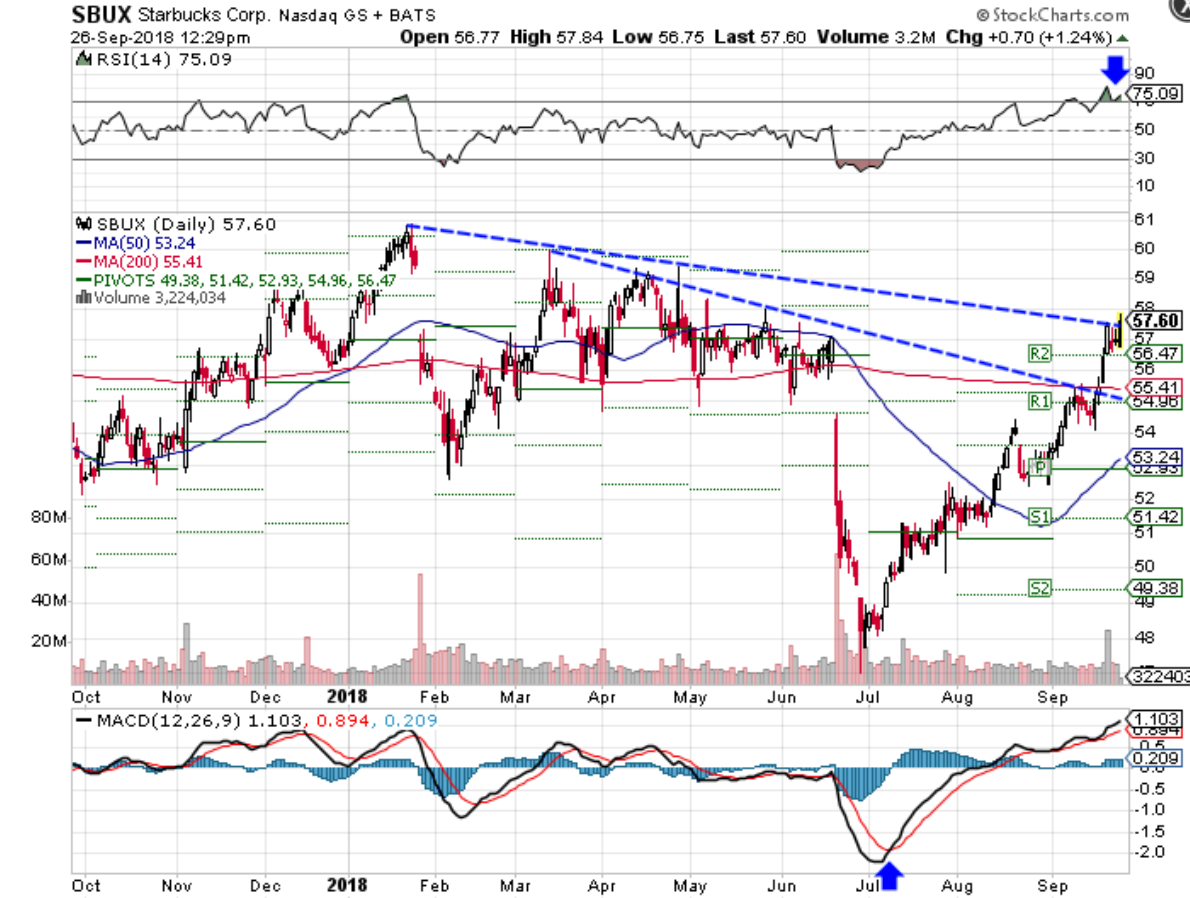Starbucks Stock Performance: Sbux Stock

Starbucks Corporation (SBUX) is a global coffeehouse giant, and its stock performance reflects the company’s growth and challenges. Examining the historical performance of SBUX stock reveals insights into the company’s trajectory and potential future direction.
Historical Performance
Starbucks stock has experienced significant growth and volatility over the years. The company went public in 1992 at $17 per share. Since then, SBUX stock has experienced periods of strong growth, driven by factors such as expanding store networks, new product launches, and increased consumer demand. However, the stock has also faced periods of decline, impacted by economic downturns, competition, and changing consumer preferences.
- Highs and Lows: SBUX stock reached an all-time high of over $113 per share in 2018, driven by strong global expansion and innovative product offerings. However, the stock experienced a significant decline in 2018 and 2019, partly due to concerns about slowing growth in China and rising competition in the coffee market.
- Significant Trends: Over the past few years, SBUX stock has shown a trend of growth and consolidation. The company has consistently focused on expanding its store network, particularly in emerging markets. Additionally, Starbucks has been investing in digital initiatives, such as mobile ordering and loyalty programs, to enhance customer experience and drive sales. The company’s focus on sustainability and social responsibility has also resonated with investors, contributing to its positive long-term performance.
Comparison with Competitors
Starbucks faces competition from other major coffee companies, including Dunkin’ Brands (DNKN), McDonald’s (MCD), and Peet’s Coffee (PEET). While SBUX stock has generally outperformed its competitors in terms of long-term growth, the company’s stock performance can be impacted by factors such as changes in consumer spending, economic conditions, and the competitive landscape.
- Dunkin’ Brands: Dunkin’ has focused on expanding its presence in the US and internationally, offering a range of coffee and baked goods. The company has also invested in digital initiatives, including mobile ordering and loyalty programs, to enhance customer experience and drive sales. However, Dunkin’s stock performance has been relatively volatile compared to Starbucks.
- McDonald’s: McDonald’s is a global fast-food giant that has been expanding its coffee offerings, including McCafé, to compete with Starbucks. The company’s focus on value and convenience has made it a formidable competitor in the coffee market. However, McDonald’s stock performance has been more closely tied to the overall fast-food industry.
- Peet’s Coffee: Peet’s Coffee is a premium coffee brand known for its high-quality coffee beans and artisanal coffee drinks. The company has a smaller footprint compared to Starbucks and Dunkin’, but its focus on specialty coffee has made it a strong competitor in certain markets. Peet’s stock performance has been relatively stable, reflecting the company’s niche positioning in the coffee market.
Key Events Impacting Stock Performance
Several events have significantly impacted SBUX stock performance in recent years, including:
- New Product Launches: Starbucks has consistently introduced new products, such as Nitro Cold Brew, plant-based milk options, and seasonal beverages, to cater to evolving consumer preferences and drive sales. These product launches have generally been well-received by investors, boosting SBUX stock performance.
- Changes in Consumer Spending: Consumer spending patterns can significantly impact the performance of coffee companies, including Starbucks. During economic downturns, consumers may reduce their spending on discretionary items, such as coffee. However, Starbucks’ focus on providing a premium experience and offering value-oriented options has helped the company weather economic fluctuations.
- Global Economic Events: Global economic events, such as the COVID-19 pandemic, can have a significant impact on SBUX stock performance. The pandemic led to widespread store closures and disruptions in supply chains, affecting the company’s revenue and profitability. However, Starbucks’ strong brand recognition, digital capabilities, and focus on safety measures helped the company navigate the pandemic and emerge with a resilient business model.
Starbucks Business Fundamentals

Starbucks, a global coffeehouse giant, boasts a strong financial position and a well-established business model. However, like any company, it faces challenges and risks that could impact its future performance. This section delves into the key aspects of Starbucks’ business fundamentals, examining its financial health, business model, and potential risks.
Financial Health, Sbux stock
Starbucks’ financial health is generally considered robust. The company has consistently generated strong revenue and profitability over the years. Its revenue has steadily increased, driven by factors such as expanding store count, new product launches, and a loyal customer base. In 2022, Starbucks’ revenue reached $32.3 billion, a significant increase from previous years.
Starbucks’ profitability is also impressive, as indicated by its high operating margins. The company’s strong brand recognition, efficient operations, and effective cost management contribute to its profitability. However, it’s important to note that Starbucks’ profitability has been impacted by factors such as rising inflation and supply chain disruptions.
Despite its profitability, Starbucks has a significant amount of debt. The company has used debt to finance its expansion plans, which has resulted in a high debt-to-equity ratio. While this debt level is manageable for now, it could pose a risk if economic conditions worsen or interest rates rise.
Business Model
Starbucks’ business model is built on a foundation of several key strengths, including:
- Strong Brand Recognition: Starbucks has a globally recognized brand, synonymous with high-quality coffee and a comfortable atmosphere. This strong brand recognition allows Starbucks to charge premium prices and attract a loyal customer base.
- Global Reach: Starbucks operates in over 80 countries, giving it a vast and expanding market presence. This global reach allows Starbucks to tap into diverse customer segments and benefit from international growth opportunities.
- Loyalty Programs: Starbucks has a successful loyalty program, “My Starbucks Rewards,” which incentivizes repeat purchases and provides valuable customer data. The program helps Starbucks build relationships with its customers and drive sales.
- Diversification: Starbucks has diversified its product offerings beyond coffee, including tea, pastries, and other food items. This diversification helps Starbucks appeal to a wider customer base and reduce its reliance on coffee sales.
However, Starbucks also faces certain weaknesses:
- High Dependence on Coffee: Despite its diversification efforts, coffee remains Starbucks’ core product, making it vulnerable to fluctuations in coffee prices and consumer preferences.
- Competition: The coffee industry is highly competitive, with numerous local and global players vying for market share. Starbucks faces competition from established chains like Dunkin’ Donuts and Peet’s Coffee, as well as smaller independent coffee shops.
- Labor Costs: Starbucks’ labor costs are significant, particularly in countries with high minimum wages. The company has faced challenges in managing labor costs and ensuring employee satisfaction.
Potential Risks and Challenges
Several factors could impact Starbucks’ future performance:
- Changing Consumer Preferences: Consumer tastes are constantly evolving, and Starbucks must adapt to changing preferences for coffee, food, and the overall café experience. This could involve introducing new products, adjusting store formats, or enhancing the customer experience.
- Economic Downturn: A global economic downturn could impact consumer spending, leading to a decline in demand for Starbucks’ products. This could be particularly challenging for Starbucks, given its premium pricing strategy.
- Regulatory Changes: Starbucks operates in a heavily regulated industry, and changes in regulations could impact its operations, such as tax increases, environmental regulations, or labor laws.
- Supply Chain Disruptions: Global supply chain disruptions, such as those caused by the COVID-19 pandemic, could impact Starbucks’ ability to source ingredients, produce its products, and operate its stores efficiently.
Future Outlook for SBUX Stock

Starbucks, a global coffee giant, has a strong track record of growth and innovation. The company is well-positioned to continue expanding its footprint and capturing market share in the coming years. However, it is crucial to consider potential risks and challenges that could impact its future performance.
Growth Drivers for Starbucks
Starbucks’ future growth is likely to be driven by a combination of factors, including:
- New Product Launches: Starbucks continuously introduces new beverages and food items to cater to evolving consumer preferences and seasonal trends. This strategy helps attract new customers and keep existing customers engaged. For example, the recent launch of the “Oatmilk Shaken Espresso” has been a hit with consumers seeking plant-based alternatives.
- Expansion into New Markets: Starbucks has a significant opportunity to expand its global presence in emerging markets with a growing middle class and a rising demand for premium coffee experiences. The company is actively pursuing growth in Asia, Africa, and Latin America, leveraging its brand recognition and operational expertise to capture market share.
- Digital Innovation: Starbucks is a leader in digital innovation, with a strong mobile ordering and loyalty program that drives customer engagement and repeat purchases. The company is continuously investing in its digital platforms to enhance customer experience, personalize offers, and streamline operations.
Potential Risks and Challenges
While Starbucks has a strong position in the market, it faces several potential risks and challenges that could impact its future performance. These include:
- Competition: The coffee market is highly competitive, with numerous local and global players vying for market share. Starbucks faces competition from established brands like Dunkin’ Donuts, McDonald’s, and independent coffee shops, as well as emerging players offering innovative concepts and value-driven offerings.
- Changing Consumer Preferences: Consumer preferences are constantly evolving, driven by factors such as health consciousness, sustainability, and the desire for personalized experiences. Starbucks needs to adapt its product offerings and marketing strategies to cater to these changing preferences to remain relevant.
- Regulatory Changes: The coffee industry is subject to various regulations related to labor practices, environmental sustainability, and food safety. Starbucks needs to navigate these regulations effectively to ensure compliance and maintain its reputation.
- Economic Fluctuations: Starbucks’ performance can be affected by economic fluctuations, such as recessions or changes in consumer spending patterns. During economic downturns, consumers may cut back on discretionary spending, which could impact Starbucks’ sales.
Key Factors Influencing SBUX Stock Performance
| Factor | Impact |
|---|---|
| New Product Launches | Increased revenue and customer engagement |
| Market Expansion | Increased market share and revenue growth |
| Digital Innovation | Enhanced customer experience, increased loyalty, and operational efficiency |
| Competition | Potential loss of market share and revenue |
| Changing Consumer Preferences | Potential decline in sales if Starbucks fails to adapt |
| Regulatory Changes | Increased costs and potential reputational damage |
| Economic Fluctuations | Potential decline in sales and profitability |
Sbux stock, a reflection of Starbucks’ performance, often fluctuates based on various factors. One of these is the compensation of key executives, like Brian Niccol, the CEO of Chipotle Mexican Grill, who, like Starbucks’ CEO, plays a significant role in shaping the company’s trajectory.
You can delve deeper into Brian Niccol’s salary and its potential impact on Chipotle’s performance here. This understanding can provide valuable insights into the financial landscape of the restaurant industry, including Starbucks’ potential trajectory.
Sbux stock has been on a roller coaster ride lately, with investors eager to see what the future holds under the leadership of starbucks ceo laxman narasimhan. His focus on innovation and customer experience could be the key to unlocking new growth for the coffee giant, ultimately impacting the trajectory of Sbux stock.
